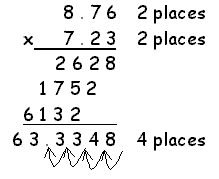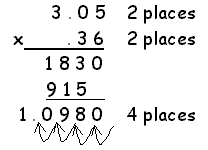| 1. |
7.6 x 5 |
Explanation: |
|

|
Multiply as if the numbers were whole numbers.
Count the number of decimal places in the factors, 1.
So your answer must also have one decimal place.
Starting at the right, count one place to the left and place your decimal between the eight and the zero.
|
2. |
3.7 x 4.5 |
Explanation: |
|

|
Multiply as if the numbers were whole numbers.
Count the number of decimal places in the factors, 1 + 1 = 2.
So your answer must also have two decimal places.
Starting at the right, count two places to the left and place your decimal between the six and the six.
|
3. |
8.76 x 7.23 |
Explanation: |
|

|
Multiply as if the numbers were whole numbers.
Count the number of decimal places in the factors, 2 + 2 = 4.
So your answer must also have four decimal places.
Starting at the right, count four places to the left and place your decimal between the 63 and the 3.
|
4. |
3.05 x .36 |
Explanation: |
|

|
Multiply as if the numbers were whole numbers.
Count the number of decimal places in the factors, 2 + 2 = 4.
So your answer must also have four decimal places.
Starting at the right, count four places to the left and place your decimal between the one and the zero.
|
5. |
.05 x .3 |
Explanation: |
|

|
Multiply as if the numbers were whole numbers.
Count the number of decimal places in the factors, 2 + 1 = 3.
So your answer must also have three decimal places.
Starting at the right, count three places to the left.
Since there are only two numbers, we must add a zero before the 1 (to the left) to make up for the third decimal place.
|
6. |
.02 x .04 |
Explanation: |
|

|
Multiply as if the numbers were whole numbers.
Count the number of decimal places in the factors, 2 + 2 = 4.
So your answer must also have four decimal places.
Starting at the right, count four places to the left.
Since there is just one number, we must add three zeroes to make a total of four decimal places.
|